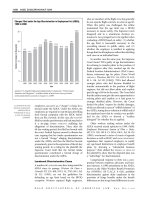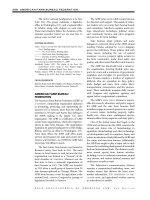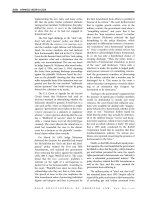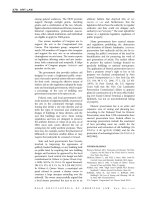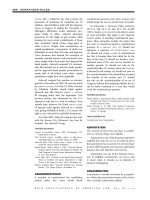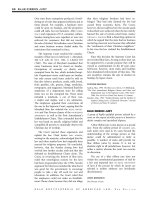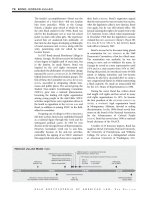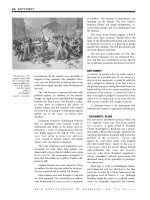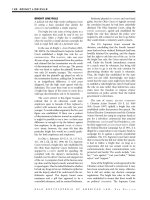Gale Encyclopedia Of American Law 3Rd Edition Volume 8 P41 pptx
Bạn đang xem bản rút gọn của tài liệu. Xem và tải ngay bản đầy đủ của tài liệu tại đây (199.68 KB, 10 trang )
accusatorial system of justice. (An accusatorial
system places the burden on the prosecution to
establish the guilt of the defendant, as opposed
to an
INQUISITORIAL SYSTEM, wherein guilt or
innocence is determined through interrogation
of the defendant.)
For 150 years, the Right to Counsel Clause
was construed as simply granting to a defendant
the right to retain a private attorney. This did
not mean that an impoverished criminal
defendant had the right to a court-appointed
attorney without cost. In 1932 the U.S. Supreme
Court began to reverse this interpretation in
POWELL V. ALABAMA, 287 U.S. 45, 53 S. Ct. 55, 77
L. Ed. 158. In Powell, nine black youths were
accused of raping a white girl in a train going
through Alabama on March 25, 1931. A sheriff’s
posse rounded up the youths and held them in
custody. The youths were not from Alabama,
and they were not given the opportunity to
contact their families.
The youths were indicted on March 31. On
April 6, they were tried with the assistance of
unprepared counsel and convicted, and subse-
quently sentenced to death. The youths thereaf-
ter received the assistance of counsel for their
appeals. The Supreme Court of Alabama
affirmed the convictions. The U.S. Supreme
Court reversed the convictions and returned the
case to the Alabama state court. According to
the Court, the trial court’s appointment of an
unprepared attorney in a capital case is a
violation of the defendant’s
DUE PROCESS rights.
The Powell decision did not mandate the
appointment of an attorney for all impoverished
defendants. The Court in Powell merely held
that due process requires the appointment of
prepared counsel to indigent defendants in a
case that involves the death penalty. Powell did,
however, provide the basis for the requirement
of free counsel for defendants faced with serious
federal charges.
In Johnson v. Zerbst, 304 U.S. 458, 58 S. Ct.
1019, 82 L. Ed. 1461 (1938), the U.S. Supreme
Court held that an indigent federal criminal
defendant who faces a serious criminal charge,
such as a felony, is entitled to an attorney at
the expense of the gover nment. According to
the Court, the right to counsel is “one of the
safeguards deemed necessary to insure
fundamental
HUMAN RIGHTS of life and liberty.”
In making this decision, the Court noted “the
obvious truth that the average defendant does
not have the professional legal skill to protect
himself.”
Significantly, the Johnson opinion did not
force states to provide the right to counsel for all
indigent criminal defendants in state court; this
right to counsel applied only to indigent
defendants facing serious charges in federal
court. In state court, by virtue of the Powell
opinion, only indigent defendants accused of
capital crimes had the right to a court-
appointed attorney. Many states did provide
for the right to an attorney for accused felons
through statutes; other states did not. In 1963
the Supreme Court corrected these inequalities
in
GIDEON V. WAINWRIGHT, 372 U.S. 335, 83 S. Ct.
792, 9 L. Ed. 2d 799.
In Gideon, defendant Clarence Gideon was
charged in a Florida state court with breaking
and entering a poolroom with the intent to
commit a misdemeanor. Under Florida law, this
was a felony. Gideon valiantly represented
himself, but he was found guilty and sentenced
to five years in prison.
On appeal to the U.S. Supreme Court,
Gideon was represented by
ABE FORTAS, who had
been appointed by the Court. Through Fortas,
Gideon argued that the right to counsel was a
FUNDAMENTAL RIGHT and essential to a fair trial.
The Court agreed, stating that the “noble ideal”
of a fair trial cannot be achieved “if the poor man
charged with a crime has to face his accusers
without a lawyer to assist him.” The Court
reversed Gideon’s conviction, holding that all
states must provide counsel to indigent defen-
dants who face serious criminal charges. The
legal basis for the decision was the Due Process
Clause of the
FOURTEENTH AMENDMENT to the U.S.
Constitution. This clause forbids states to enact
laws denying
DUE PROCESS OF LAW to citizens of
the United States. On retrial, represented by
appointed counsel, Gideon was acquitted.
In a companion case decided the same day
as Gideon , the U.S. Supreme Court created the
right to counsel for indigent defendants on
appeal. In Douglas v. California, 372 U.S. 353,
82 S. Ct. 814, 9 L. Ed. 2d 811 (1963), defendants
WILLIAM DOUGLAS and Bennie Will Meyes,
represented by a single PUBLIC DEFENDER, were
tried jointly in a California state court and
convicted of various felonies. Both defendants
appealed to the California District
COURT OF
APPEAL
. This first appeal was granted as a matter
of righ t to all criminal defendants. Under
California law, however, indigent defendants
GALE ENCYCLOPEDIA OF AMERICAN LAW, 3RD E DITION
388 RIGHT TO COUNSEL
did not have the right to an appointed attorney
for the first appeal.
Douglas and Meyes, both indigent, prepared
and filed their own appellate briefs. The District
Court of Appeal affirmed the convictions. Meyes
petitioned to the California Supreme Court for
himself and on behalf of Douglas. That court
denied the petition without a hearing.
On appeal to the U.S. Supreme Court,
Douglas and Meyes, this time represented by
Supreme Court-appointed counsel, argued that
they deserved the right to an attorney on their
appeal. The Court agreed, lecturing that “there
can be no equal justice where the kind of an
appeal a man enjoys ‘depends on the amount of
money he has” (Griffin v. Illinois, 351 U.S. 12,
76 S. Ct. 585, 100 L. Ed. 891 [1956]). According
to the Court in Douglas, the
EQUAL PROTECTION
and Due Process Clauses of the Fourteenth
Amendment prevent states from granting crim-
inal appeals in such a way as to discriminate
against poor people.
Thus, under the Douglas decision, a state
must provide free counsel to indigent defen-
dants on appeal, if the state offers an appeal as a
matter of right. All states do allow one appeal as
a matter of right. For discretionary appeals, or
appeals that are not granted as a matter of
right—such as appeals to the state’s highest
court in states with a lower reviewing court, and
appeals to the U.S. Supreme Court—there is no
right to counsel. However, many states maintain
laws that provide free counsel to indigent
defendants even for these discretionary appeals.
A year after Gideon and Douglas, the
Supreme Court decided two more cases that
further extended a defendant’s right to counsel.
In
MASSIAH V. UNITED STATES, 377 U.S. 201, 84 S.
Ct. 1199, 12 L. Ed. 2d 246 (1964), defendant
Winston Massiah was indicted by a federal
GRAND JURY on narcotics charges. Massiah
retained a lawyer and pleaded not guilty. While
free on bail, Massiah was contacted by a
codefendant, Jesse Colson. Unbeknownst to
Massiah, Colson was cooperating with federal
law enforcement authorities. Massiah and
Colson met and spoke in an automobile for
several hours about the case, and Massiah made
incriminating statements that were transmitted
by radio to a federal agent located a few bloc ks
away. The statements were used as evidence in
Massiah’s trial. Massiah was convicted and
sentenced to nine years in prison.
On appeal to the Supreme Court, Massiah
argued that he had the right to counsel while
being interrogated by law enforcement, even
when the interrogation w as not conducted in
person by an officer. The Court agreed and
reversed Massiah’s conviction. The Court in
Massiah established that the police may not
interrogate someone who has been indicted
unless the person’s attorney is present or the
person has knowingly waived the right to have
counsel present.
Approximately one month later, the Su-
preme Court extended Massiah in
ESCOBEDO V.
ILLINOIS, 378 U.S. 478, 84 S. Ct. 1758, 12 L. Ed.
2d 977 (1964). In Escobedo , defendant Danny
Escobedo was arrested and taken to police
headquarters for questioning regarding the
recent
MURDER of his brother-in-law. Escobedo
was not indicted for the crime. However, he was
held in police custody and was not free to leave.
Escobedo’s retained attorney arrived at police
headquarters while Escobedo was being ques-
tioned, but the police prevented the two from
speaking to each other. Under interrogation,
Escobedo admitted to some knowledge of the
murder. Eventually, he confessed to having
participated in the crime.
At trial, Escobedo’s statements were admit-
ted as evidence, and Escobedo was convicted of
murder. On appeal, the Supreme Court over-
turned Escobedo’s conviction. The Court spe-
cifically held that where an investigation is “no
longer a general inquiry into an unsolved crime
but has begun to focus on a particular suspect,”
the suspect is effectively in custody and has the
right to consult a lawyer. Citing the prolific legal
theorist Dean
JOHN HENRY WIGMORE, the Court
warned that any criminal justice system that
relies on “compulsory self-disclosure as a source
of proof must itself suffer morally thereby.”
The Escobedo opinion established that when a
suspect asks to speak with an attorney, the police
must comply with the request, even before
formal charges have been filed against the suspect.
After this slew of right-to-counsel cases, it
remained for the Supreme Court to decide
which criminal charges required the availability
of free counsel. Under Johnson and Gideon, a
defendant had the right to counsel for all
“serious” cases, but this standard proved
difficult to apply. To clarify this aspect of the
right to counsel, the Court seized on Argersinger
v. Hamlin, 407 U.S. 25, 92 S. Ct. 2006, 32 L. Ed.
2d 530 (1972).
GALE ENCYCLOPEDIA OF AMERICAN LAW, 3RD E DITION
RIGHT TO COUNSEL 389
In Argersinger, the defendant, Jon Richard
Argersinger, an indigent person, was charged in
a Florida state court with carrying a concealed
weapon. The offense carried a punishment of
up to six months in prison and a $1,000 fine.
Proceeding without counsel, Argersinger was
convicted and sentenced to 90 days in jail.
On appeal, the Supreme Court vacated
Argersinger’s conviction. The Court co ncluded
that “the problems associated with misde-
meanor and petty offenses often require the
presence of counsel to ensure the accused a fair
trial.” Under the rule formulated in Argersinger,
an indigent defendant who is not offered the
services of a court-appointed attorney at trial
may not be sente nced to prison, even if the
defendant is convicted of a crime for which
INCARCERATION is an authorized punishment.
Pursuant to the case, when a court determines
that incarceration is a possible result of the
proceedings, the court must inform the defen-
dant not represented by an attorney of the right
to representation. If the respondent is indigent,
the court must inform the defendant of the
right the appo intment of an attorney. Con-
versely, if an indigent defendant will not be
incarcerated as a result of the proceedings, the
court may require the defendant to proceed
without an attorney.
The apparent fairness of the rule established
in Argersinger can be deceiving. In Nichols v.
United States, 511 U.S. 738, 114 S. Ct. 1921, 128
L. Ed. 2d 745 (1994), defendant Kenneth O.
Nichols pleaded guilty in federal court to
CONSPIRACY to distribute cocaine. Nichols was
sentenced to 19 years and seven months in
prison. To justify this lengthy term, the
sentencing court relied on a previous misde-
meanor conviction that resulted from a trial in
which Nichols was not represented by counsel.
When Nichols appealed the sentence, the
Supreme Court held that it is not a violation
of the Sixth and Four teenth Amendments to
enhance punishment based on a prior convic-
tion in which an indigent defendant was not
afforded an attorney.
The Supreme Court has, at times, displayed
considerable latitude in deciding various right-
to-counsel issues. It has held that an indigent
defendant has the right to counsel in deciding
whether to submit to a psychiatric examination
when statements made during that examination
may be used at trial (Estelle v. Smith, 451 U.S.
454, 101 S. Ct. 1866, 68 L. Ed. 2d 359 [1981]).
Under United States v. Wade, 388 U.S. 218, 87 S.
Ct. 1926, 18 L. Ed. 2d 1149 (1967), an indigent
defendant has the right to have appointed
counsel present during post-indictment identi-
fication lineups. Under the Sixth Amendment,
juveniles have the right to an attorney when
their liberty is at stake (Application of Gault, 387
U.S. 1, 87 S. Ct. 1428, 18 L. Ed. 2d 527 [1967]).
The Court has also read the Sixth Amend-
ment to mean that a criminal defendant is
entitled to effective legal counsel. This means
that a defendant has the right to conscientious,
meaningful representation. If a defendant does
not receive effective assistance of counsel at
trial, the conviction will be reversed. However,
the standard of proof for the defendant is high.
Under Strickland v. Washington, 466 U.S. 668,
104 S. Ct. 2052, 80 L. Ed. 2d 674 (1984),
the defendant has to prove not only that the
attorney’s performance was less than reasonable
but that this substandard performance changed
the outcome of the trial. The second factor is
very hard to prove, especially when the evidence
of guilt is overwhelming. Nevertheless, courts
will overturn convictions when it finds that a
defense lawyer was asleep during critical parts of
the proceedings. Claims of ineffective counsel
are often made against co urt-appointed lawyers,
whether they are members of a public defen-
der’s office or individuals chosen by a trial
judge. Absent egregious behavior by a lawyer
such claims are usually unsuccessful because a
liberal attitude w ould lead to second-guessing
the decisions of trial counsel by appellate courts .
The Supreme Court has been less generous
to identify the right to counsel on other issues.
Generally, an indigent defendant has no right
to counsel in a proceeding after conviction
(Pennsylvania v. Finley, 481 U.S. 551, 107 S. Ct.
1990, 95 L. Ed. 2d 539 [1987]). An indigent
defendant does not have an absolute right to
counsel for revocation of
PAROLE or PROBATION
hearings (Gagnon v. Scarpelli, 411 U.S. 778, 93
S. Ct. 1756, 36 L. Ed. 2d 656 [1973]). If the
parolee or
PROBATIONER denies committing the
offense or if there are
MITIGATING CIRCUMSTANCES
that may limit the parolee or probationer’s guilt,
the court may appoint an attorney. An indigent
defendant has no constitutional right to an
attorney for a
HABEAS CORPUS petition (Finley)
unless the defendant faces death, in which case
he or she is entitled to an attorney for a habeas
corpus petition (McFarland v. Scott, 512 U.S.
849, 114 S. Ct. 2568, 129 L. Ed. 2d 666 [1994]).
GALE ENCYCLOPEDIA OF AMERICAN LAW, 3RD E DITION
390 RIGHT TO COUNSEL
An indigent defendant has the right to
appointed counsel during pre-indictment iden-
tification lineups conducted by the police (Kirby
v. Illinois, 406 U.S. 682, 92 S. Ct. 1877, 32 L. Ed.
2d 411 [1972]). Kirby would seem to contradict
Escobedo, where the defendant was entitled to
counsel after arrest but before
INDICTMENT.
However, Escobedo has been limited to its facts
and has been constr ued as upholding the
defendant’s right against
SELF-INCRIMINATION
more than the right to counsel.
The Supreme Court has carved out other
exceptions to the right to counsel after an arrest.
It has allowed law enforcement officials to have
EX PARTE contacts with defendants to determine
whether the defendant is in fact represented
by counsel. It has also allowed ex parte
communications that are made with the consent
of defendant’s counsel; those made pursuant
to discovery procedures, such as subpoenas;
communications in the course of a criminal
investigation; communications necessary to pro-
tect the life or safety of another person; and those
made by a represented person, so long as the
person has knowingly, intelligently, and volun-
tarily waived the right to have counsel present.
These exceptions apply to all persons, regardless
of whether they can afford their own attorney.
Finally, law enforcement officials need not
advise criminal suspects of their right to an
attorney until those suspects are actually taken
into custody or are not free to leave the presence
of the officers. This rule gives law enforcement
the freedom necessary to conduct reasonable
investigations for the safety of the general
public.
Congress sought to restric t the ability of
convicted defendants to argue success fully that
they received ineffective counsel when it passed
the Anti-Terrorism and Effective Death Penalty
Act of 1996, Pub. L. No. 104-132, 110 Stat.
1214. A provision of this act states that federal
courts may not grant habeas petitions unless
they find that the state court proceedings
“resulted in a decision that was contrary to, or
involved an unreasonable application of, clearly
established federal law.” The Supreme Court
has ruled that “clearly established federal law”
means a decision it has rendered. In Bell v.
Cone, 535 U.S. 685, 122 S. Ct. 1843, 152 L. Ed.
2d 914 (2002), the Court had to decide which of
its precedents constituted “clearly established
federal law.” It ruled that its more stringent
precedent in Strickland v. Washington controlled
in this case, signaling that it wished to limit
successful death penalty appeals.
FURTHER READINGS
Marcus, Paul, and Jack Zimmerman. 2009. Miranda
Criminal Procedure in Practice. 3d ed. Louisville, Co.:
National Institute for Trial Advocacy.
Saltzburg, Stephen A., Daniel J. Capra, and Angela J. Davis.
2009. Basic Criminal Procedure. 5th ed. St. Paul, Minn.:
West.
Sonneborn, Liz. 2004. Miranda v. Arizona: The Rights of the
Accused. New York: Rosen.
Tomkovicz, James J. 2002. The Right to the Assistance of
Counsel: A Reference Guide to the United States
Constitution. Westport, Conn.: Greenwood Press.
CROSS REFERENCES
Criminal Law; Criminal Procedure; Due Process of Law;
Gault, In re; Juvenile Law; Miranda v. Arizona.
RIGHT TO DIE
See DEATH AND DYING; EUTHANASIA.
RIGHT-TO-WORK LAWS
State laws permitted by section 14(b) of the TAFT-
HARTLEY ACT that provide in general that employees
are not required to join a union as a condition of
getting or retaining a job.
Right-to-work laws forbid unions and
employers to enter into agreements requiring
employees to join a union and pay dues and fees
to it in order to get or keep a job. Twenty-one
states, mostly in the South and West, have right-
to-work laws.
The ability of states to pass right-to-work
laws was authorized by the Taft-Hartley Act of
1947, also known as the
LABOR MANAGEMENT
RELATIONS ACT
(29 U.S.C.A. § 141 et seq.). Taft-
Hartley, which sought to curtail union power in
the workplace, amended the National Labor
Relations Act (NLRA) of 1935 (29 U.S.C.A.
§ 151 et seq.). The NLRA as first passed
preempted state regulation of labor relations
in interstate commerce, with the goal of
developing a national
LABOR LAW. Taft-Hartley
departed from this goal in section 14(b) (29
U.S.C.A. § 164[b]), expressly authorizing the
states to adopt right-to-work measures. Orga-
nized labor has tried repeatedly, without success,
to secure the repeal of section 14(b). The Federal
Railway Labor Act (45 U.S.C.A. § 151 et seq.)
prevents the application of state right-to-work
laws to the railroad and airline industries.
GALE ENCYCLOPEDIA OF AMERICAN LAW, 3RD E DITION
RIGHT-TO-WORK LAWS 391
Section 14(b) works with other provisions
of Taft-Hartley to limit the ability of unions to
mandate compulsory union membership. Sec-
tions 8(a)(3) and 8(b)(2) prohibit a type of
union security clause (a provision that describes
the obligations of employees to support the
union) from being inserted into a collective
bargaining agreement. A closed shop clause
obligates the employer to hire only union
members and to discharge any employee who
drops union membership. The
CLOSED SHOP is
forbidden under Taft-Hartley.
Although the act permits the union shop,
section 14(b) allows the states to prohibit it. A
union shop clause requires an employee to
become a member of the union in order to
retain a job, although no one needs to be a
member in order to be hired; every newly hired
person has a prescribed period of time to
become a member.
Section 14(b) also allows states to prohibit
the agency shop. An agency shop clause requires
every company employee to pay to the union an
amount equal to the union’s customary initia-
tion fees and monthly dues. It does not require
the employee to become a formal member of
the union, be a member before being hired, take
an oath of obligation, or observe any internal
rules and regulations of the union except with
regard to dues. The U.S. Supreme Court, in
National Labor Relations Board v. General Motors
Corp., 373 U.S. 734, 83 S. Ct. 1453, 10 L. Ed. 2d
670 (1963), held that an employer does not
violate the NLRA by agreeing to include an
agency shop clause in a bargaining agreement.
Therefore, when a state passes a right-to-
work law, it prohibits both mandatory union
membership and initiation fees and dues obliga-
tions of agency shops, and permits employees
who do not voluntarily pay dues and initiation
fees to receive the benefits the union provides.
Unions call such people “free riders.”
Right-to-work advocates argue that no
person should be forced to become a union
member or to provide financial support for a
labor organization as a condition of employ-
ment. Such compulsion is said to be contrary to
the U.S. concept of individual rights and
FREEDOM OF ASSOCIATION. It is also alleged that
compulsory unionism enables large labor orga-
nizations to exert excessive power in the
workplace and in the political arena.
Organized labor believes that right-to-work
laws allow free riders at the expense of their
fellow workers. Opponents of these laws argue
that everyone should pay a proportionate share
of the costs of the union in negotiating contract
benefits that will go to all. Unions also maintain
that the real objective of right-to-work laws is to
sow dissension among workers and thus weaken
the labor movement.
The bitter controversy over right-to-work
laws peaked in the 1950s, when almost every
state legislature consid ered the issue. Some
scholars suggest the importance of the issue
has been exaggerated. Studies have indicated
that where unions are well established, employ-
ees tend to enroll without regard to right-to-
work statutes. Such laws may be more a
symptom than a cause of union weakness in
certain industries and geographical areas.
FURTHER READINGS
Hogler, Raymond L., and Robert LaJeunesse. 2002. “Okla-
homa’s Right to Work Initiative: Labor Policy and
Political Ideology.” Labor Law Journal 53 (fall): 109–21.
Hunter, Robert P. 2002. “The Effect of Right-to-Work Laws
on Economic Development.” Government Union Review
20 (summer): 27–30
Sumner, David G. 1984. “Plumbers and Pipefitters:
The Need to Reinterpret the Scope of Compulsory
Unionism.” American Univ. Law Review 33.
Thomas, James C. 2007. “Right-to-Work: Settled Law or
Unfinished Journey.” Loyola Journal of Public Interest
Law 8 (spring).
CROSS REFERENCES
Collective Bargaining; Labor Law; Labor Union.
RIOT
A riot is a disturbance of the peace by several
persons, assembled and acting with a common
intent in executing a lawful or unlawful enterprise
in a violent and turbulent manner.
Riot, rout, and
UNLAWFUL ASSEMBLY are related
offenses, yet they are separate and distinct. A
rout differs from a riot in that the persons
involved do not actually execute their purpose
but merely move toward it. The degree of
execution that converts a rout into a riot is often
difficult to determine.
An unlawful assembly transpires when
persons convene for a purpose that, if executed,
would make them rioters, but who separate
without performing any act in furtherance of
their purpose. For example, when a restaurant
owner refused to serve a certain four customers
and barred them from entering the establish-
ment, the four men remained in front of the
doors of the restaurant and blocked the entrance
GALE ENCYCLOPEDIA OF AMERICAN LAW, 3RD E DITION
392 RIOT
to all other customers. Although a riot did not
result from their actions, the men were arrested
and convicted of unlawful assembly.
Inciting to riot is another distinct crime, the
gist of which is that it instigates a
BREACH OF THE
PEACE
, even though the parties might have
initially assembled for an innocent purpose. It
means using language, signs, or conduct to lead
or cause others to engage in conduct that, if
completed, becomes a riot. The
SUPREME COURT,
in Brandenburg v. Ohio, 395 U.S. 444, 89 S. Ct.
1827, 23 L. Ed. 430 (1969), held that free speech
is protected and may not be prohibited solely on
the idea expressed. It drew the line at speech or
conduct that sought to incite imminent lawless
action, but the state must show that the
incitement was likely to result in such action.
CONSPIRACY to riot is also a separate offense.
In one case, the leader of a small Marxist group
took to the streets preaching revolution and
organized resistance to lawful authority. Curs-
ing the police, he spoke about how to fight and
kill them and generally advocated violent means
to gain political ends. The court ruled that a
person who agrees with others to organize a
future riot and who commits an
OVERT ACT in
conformity with the agreement is guilty, not of
riot, but of conspiracy to riot.
In legal usage, the term mob is practically
synonymous with riot or with riotous assembly.
A federal court held that night riders were a
mob and that their act of burning a building
constituted the crime of riot.
Nature and Elements
Riot is an offense against the public peace and
good order, rather than a violation of the rights
of any particular person. It is not commonly
applied to brief disturbances, even if
MALICIOUS
MISCHIEF
and violence are involved in the
commotion. For example, a lock company was
picketed in a labor dispute. When the police
attempted to escort some people through the
picket line, a brief general commotion, some
scuffling, and an exchange of blows took place.
The police testified that the entire fracas lasted
about “two or three minutes.” The court held
that the crime of riot does not apply to brief
disturbances, even those involving violence, nor
to disturbances that occur during the
PICKETING
accompanying a labor dispute.
The elements that comprise the offense are
determined either by the
COMMON LAW or by
the statute defining it. In some jurisdictions, the
necessary elements are an unlawful assembly,
the intent to provide mutual assistance against
lawful authority, and acts of violence . Under
some statutes, the elements are the use of force
or violenc e, or threats to use force and violence,
along with the immediate power of execution.
Other statutes provide that the essential
elements are an assembly of persons for any
unlawful purpose; the use of force or violence
against pe rsons or property; an attempt or
threat to use force or violence or to do any
unlawful act, coupled with the power of
immediate execution; and a resulting
DISTUR-
BANCE OF THE PEACE
.
The element of force or violence required
under the common law means a defiance of
lawful authority and the rights of other persons.
Similarly the force or violence contemplated by
the statutes is the united force of the partici-
pants acting in concert with the increased
capacity to overcome resistance. The statutes
further specify that the type of force and
violence, not mere physical exertion, must
threaten law-abiding nonpa rticipants.
Riotous Conduct
Riots can arise from any violent and turbulent
activity of a group, such as bands of people
creating an uproar and displaying weapons;
wildly marching on a pu blic street; violently
disrupting a public meeting; threatening bystan-
ders with displays of force; or forcibly destroy-
ing property along the way. In one case, striking
orange pickers armed with clubs, metal cables,
sticks, and other weapons rushed into an orange
grove and assaul ted nonstriking pickers. Af ter
the nonstrikers were driven out of the grove, the
strikers overturned the boxes full of picked
oranges and threw oranges and boxes at the
nonstrikers. The court held this to be riotous
conduct. When on e city was wracked by racial
disturbances, the court ruled that racial dis-
orders constituted a general riot, or a series of
riots, and that whether there was a single,
identifiable group or a number of riotous
groups was not significant when their one
common purpose was to injure and destroy.
One of the most brutal riots in the United
States was the Tulsa race riot. In May 1921, a
white man from Tulsa, Oklahoma, was allegedly
assaulted by an African American man. A white
mob stormed the city’s Greenwood neighbor-
hood, a prosperous community that was pre-
dominantly African American, to find the alleged
GALE ENCYCLOPEDIA OF AMERICAN LAW, 3RD E DITION
RIOT 393
assailant. Over a two-day period, 35 city blocks
in Greenwood were destroyed. Private homes,
businesses, and even churches were burned
down, and an estimated 300 people killed.
Number of Persons Necessary
The common law rule, and most of the statutes
that define riot, require three or more persons
to be involved. Some statutes fix the minimum
number at two.
Purpose of Original Assembly
The jurisdictions differ on whether the original
assembly must be an unlawful one. Some require
premeditation by the rioters, but others prescribe
that riots can arise from assemblies that were
originally lawful or as a result of groups of
persons who had inadvertently assembled.
Common Intent
A previous agreement or conspiracy to riot is
not usually an element of a riot. A common
intent, however, to engage in an act of violence,
combined with a concert of action, is sometimes
necessary. In one case, following a high school
football game, a group of boys staged a “violent,
brutal and indecent”
ASSAULT on the color guard
and band members of the visiting team. When
the visitors attempted to leave, the attacks
continued. On trial, the attackers claimed that
the charge of riot did not apply to them because
they had had no “common intent.” The court
held that “an intent is a mental state which can
be inferred from conduct.” They were found
guilty of riot and the decision was affirmed on
appeal.
Terror
When a riot arises from an unlawful act, such as
an assault, terror need not be shown because in
every riotous situation there are elements of
force and violence that are by their very nature
terrifying. When a riot arises from lawful conduct,
terror must be shown. For example, if a group of
neighbors decides to remove a nuisance, such
as a pile of malodorous garbage, which would be
a lawful activity, but does so in a violent and
tumultuous manner, terror would have to be
shown before the conduct would constitute a riot.
In 1999, the World Trade Organization (WTO)
held a five-day meeting in Seattle, Washington.
Some 45,000 protesters converged on the meeting,
protesting the WTO’s stand on everything from
the environment to global business to
HUMAN
RIGHTS
. What was supposed to be an organized
mass movement quickly degenerated into a
rampage through the city, in which buildings
were vandalized, stores were looted, and police
were attacked. Only one person need be alarmed
to fulfill the terror requirement for a riot; in
Seattle, the entire city was subjected to the terror.
Persons Liable
Principal rioters are those who are present and
actively participate in the riot. All persons
present who are not actually assisting in the
suppression of the riot can be regarded as
participants when their presence is intentional
and tends to encourage the rioters.
Municipal Liability
In the absence of a statute, a MUNICIPAL CORPORA-
TION
, such as a city, town, or village, is not liable
for injuries caused by mobs or riotous assem-
blages. Where statutes do impose liability, the
particular statute determines the type of action
one can institute against a city, town, or village.
Defenses
There is never any justification for a riot. The
only defense that can be claimed is that an
element of the offense is absent. Participation is
an essential element. Establishing that an
individual’s presence at the scene of a riot was
accidental can remove any presumption of guilt.
Suppression of Riot
Private person s can, on their own authority,
lawfully try to suppress a riot, and courts have
ruled that they can arm themselves for such
a purpose if they comply with appropriate
Riot policemen arrest
a women during the
1999 World Trade
Organization riots in
Seattle.
AP IMAGES
GALE ENCYCLOPEDIA OF AMERICAN LAW, 3
RD E DITION
394 RIOT
statutory provisions concerning the possession
of firearms or other weapons. Execution of this
objective will be supported and justified by
law. Generally every citizen capable of bearing
arms must help to suppress a riot if called upon
to do so by an authorized peace officer.
The state is primarily responsible for
protecting lives and property from the unlawful
violence of mobs. If the
MILITIA reports to civil
authorities to help quash a riot, it has the same
powers as civil officers and must render only
such assistance as is required by civil authorities.
During the WTO riot in Seattle, 600 state
troopers and 200 members of the
NATIONAL
GUARD
were called in to assist the overwhelmed
Seattle police force.
In an emergency, and in the absence of
constitutional restrictions, a governor can order
the intervention of the militia to suppress a riot
without complying with statutory formalitie s.
When troops are ordered to quell a riot, they are
not subject to local authorities but are in the
service of the state.
FURTHER READINGS
Brophy, Alfred L. 2002. Reconstructing the Dreamland: The
Tulsa Riot of 1921: Race, Reparations, and Reconciliation.
New York: Oxford Univ. Press.
Carter, David. 2008. Stonewall: The Riots that Sparked the
Gay Revolution. New York: St. Martin’s Griffin.
Gale, Dennis E. 1996. Understanding Urban Unrest: From
Reverend King to Rodney King. Thousand Oaks, Calif.:
Sage.
CROSS REFERENCE
Brandenburg v. Ohio.
RIPARIAN RIGHTS
The rights, which belong to landowners through
whose property a natural watercourse runs, to the
benefit of such stream for all purposes to which it
can be applied.
Riparian water, as distinguished from flood
water, is the water that is below the hig hest line
of normal flow of the river or stream.
CROSS REFERENCE
Water Rights.
RIPENESS
Ripeness is the mandate contained in Article III of
the Constitution that requires an appellate court
to consider whether a case has matured into a
controversy worthy of adjudication before it can
hear the case.
An actual, current controversy worthy of
ADJUDICATION must exist before a federal court
may hear a case. The court determines if a
controversy between parties with adverse legal
interests is of sufficient immediacy and reality to
warrant judicial intervention (Lake Carriers’
Ass’n v. MacMullan, 406 U.S. 498, 92 S. Ct.
1749, 32 L. Ed. 2d 257 [ 1972 ]).
The rationale behind the ripeness limitation
is to prevent the courts from entering a
controversy before it has solidified or before
other available remedies have been exhausted.
In disputes involving regulations or decisions
promulgated by administrative agencies, a
controversy is not considered ripe until the
agency’s decision has been formalized and the
challenging parties have felt its effects. Similarly,
if a state court remedy is available, a controversy
is not ripe for federal court review until all state
court remedies have been exhausted.
The courts generally apply a two-part test to
determine if a controversy is ripe for judicial
intervention. The first criterion is whether the
controversy is fit for judicial decision, that is,
whether it presents a
QUESTION OF LAW rather
than a
QUESTION OF FACT. Secondly, the courts
determine the impact on the parties of with-
holding judicial consideration. In Abbott Labo-
ratories v. Gardner (387 U.S. 136, 87 S. Ct. 1507,
18 L. Ed. 2d 681 [1967]), the
SUPREME COURT
examined whether a regulation that required
drug manufacturers to use labels showing both
the generic and the proprietary drug names was
ripe for review before it was actually enforced.
The Court held that the controve rsy was ripe
because the regulation had an immediate and
expensive impact on the plaintiffs’ day-to-d ay
operations and the plain tiffs risked a substantial
sanction if they did not comply with the
regulation.
Ripeness is a major consideration when
parties seek injunctive or declarative relief
before a statute or regulation has been applied.
Courts are reluctant to enter an abstract
disagreement over administrative policies
(Ruckelshaus v. Monsanto, 467 U.S. 986, 104 S.
Ct. 2862, 81 L. Ed. 2d 815 [1984].) However, in
some cases, the courts will hear a request for
an
INJUNCTION or DECLARATORY JUDGMENT if the
question presented is entirely or substantially
legal and if postponing a decision until after a
statute or regulation is applied would work a
substantial hardship on the challenging party
GALE ENCYCLOPEDIA OF AMERICAN LAW, 3RD E DITION
RIPENESS 395
(Pacific Gas and Electric Co. v. State Energy
Resources Conservation & Development Commis-
sion, 461 U.S. 190, 103 S. Ct. 1713, 75 L. Ed. 2d
752 [1983]).
FURTHER READINGS
American Law Institute—American Bar Association. 1993.
The “Ripeness” Mess in the Federal Courts, by Michael
M. Berger. Course of study, September 30, 1993. C872
ALI-ABA 41.
American Law Institute—American Bar Association. 1996.
The Ripeness Mess: Part I—Getting into State Court, by
Michael M. Berger. Course of study, October 17, 1996.
SB14 ALI-ABA 155.
Chemerinsky, Erwin. 2007. Federal Jurisdiction. 5th ed.
New York: Aspen.
CROSS REFERENCE
Case or Controversy.
RISK
The potential danger that threatens to harm or
destroy an object, event, or person.
A risk that is specified in an insurance policy
is a contingency which might or might not
occur. The policy promises to reimburse the
person who suffers a loss resulting from the risk
for the amount of damage done up to the
financial limits of the policy.
In sales transactions, the contract and the
UNIFORM COMMERCIAL CODE (UCC) determine
who bears responsibility for the risk of loss of
the merchandise until the buyer takes posses-
sion of the goods.
RISK ARBITRAGE
The purchase of stock in a corporation that
appears to be the target of an imminent takeover
in the hope of making large profits if the takeover
occurs.
Risk arbitrage is practiced by investors called
risk arbitrageurs. The strategy can return large
profits if a takeover occurs but can also result in
large losses if the transaction does not take
place. Obviously, then, the more information an
arbitrageur has about a possible takeover, the
less risk the strategy involves. Buying
SECURITIES
of takeover candidates on the basis of rumors is
legal, but it is illegal for an arbitrageur to
purchase securities based on inside, or nonpub-
lic, information. Insider trading violates rule
10(b)-5 of the Securities Exchange Act of 1934,
15 U.S.C.A. § 78a et seq., which is a federal law
that governs the operation of the stock
exchanges and over-the-counter trading.
To obtain information, arbitrageurs often
develop relationships with investment banking
firms and corporations, as well as with other
sources of information and financial backing.
These activities alone do not constitute a
violation of the Securities Exchange Act, but if
the risk arbitrageur uses these relationships or
resources to gather information that is not
available to the general public, the resulting
purchase of securities is illegal.
In the late 1980s, the
SECURITIES AND EXCHANGE
COMMISSION
(SEC) began to investigate several
prominent risk arbitrageurs for their roles in
insider trading. This action, combined with
the increasing number of corporate takeovers,
brought the issue of risk
ARBITRAGE to the
headlines of Wall Street and the world. Between
1980 and 1988 in the U.S. District Court for
the Southern District of New York alone, 57
arbitrageurs were criminally prosecuted for
insider trading. One of the best-known cases
involved risk arbitrageur Ivan Boesky, who
allegedly realized a $9.075 million net profit
through stock trades he made based on
nonpublic information about three different
mergers and takeovers. As part of the settlement
with the SEC and the federal courts, Boesky was
barred from any future securities trading.
Because risk arbitrage can involve significant
blocks of shares worth hundreds of thousands,
even millions, of dollars, this practice can have a
large impact on both the market and the value
of the company’s stock. Professionals in the
securities field generally agree that risk arbitrage
based on inside information has a negative
effect on the market, as well as on the
reputation of arbitrageurs in general. Many of
these commentators, however, are concerned
that existing securities laws do not reach risk
arbitrageurs who do not owe a fiduciary duty to
the people who are harmed by the arbitrageur’s
use of nonpublic information. The Securities and
Exchange Act specifies that a violation of rule
10(b)-5 requires the accused violator to have
breached a fiduciary duty to the injured party.
Chiarella v. United States, 445 U.S. 222, 100
S. Ct. 1108, 63 L. Ed. 2d 348 (1980), is one of
the leading cases on rule 10(b)-5 liabilit y.
Vincent F. Chiarella was employed at a financial
printer and, as part of his duties, handled a
series of documents that detailed an upcoming
GALE ENCYCLOPEDIA OF AMERICAN LAW, 3RD E DITION
396 RISK
takeover bid; although the nam es were left
blank or falsified, Chiarella was able to figure
out the companies involved. Then, without
disclosing that he had inside information, he
bought stock in the companies that were
targeted in the takeover; when the takeover
was made public, he sold the shares and made a
profit of approximately $30,000. Shortly there-
after, Chiarella was indicted on 17 counts of
violating rule 10(b)-5. The U.S. Supreme Court
reversed the conviction, however, on the
grounds that Chiarella had not violated the rule
because he was not a fiduciary and therefore did
not have a duty to disclose.
FURTHER READINGS
Hazen, Thomas Lee. 1989. “Volatility and Market Ineffi-
ciency: A Commentary on the Effects of Options,
Futures, and Risk Arbitrage on the Stock Market.”
Securities Law Review 21.
Steckman, Laurence A. 1988. “Risk Arbitrage and Insider
Trading—A Functional Analysis of the Fiduciary Con-
cept under Rule 10b-5.” Touro Law Review 5 (October).
Wyser-Pratte, Guy. 2009. Risk Arbitrage. Hoboken, NJ.:
John Wiley & Sons, Inc.
CROSS REFERENCE
Mergers and Acquisitions.
RIVERS
See BOUNDARIES; INTERNATIONAL WATERWAYS; WATER
RIGHTS
.
ROBBERY
The taking of money or goods in the possession of
another, from his or her person or immediate
presence, by force or intimidation.
Robbery is a crime of theft and can be
classified as
LARCENY by force or by threat of force.
The elements of the crime of robbery include the
use of force or intimidation and all the elements
of the crime of larceny. The penalty for robbery
is always more severe than for larceny.
According to statistics from the
FEDERAL
BUREAU OF INVESTIGATION
(FBI), 422,921 incidents
of robbery occurred in 2001. This number was
significantly lower than a decade earlier. The
FBI estimated that between 1992 and 2001,
the number of robberies in the United States
dropped by 37.1 percent. According to the 2001
statistics, robbery accounted for 29.4 percent of
violent crimes in the United States, costing
victims a total of $532 million. The average loss
per victim during that year was $1258.
The general elements of robbery are the
taking of
PERSONAL PROPERTY or money from the
person or presence of another, the use of actual
or constructive force, the lack of consent on the
part of the victim, and the intent to steal on the
part of the offender. Neither deliberation nor
premeditation is necessary, nor is an express
demand for the property.
Robbery requires a taking of prop erty from
the person or presence of the victim, which
means that the taking must be from the victim’s
possession, whether actual or constructive.
Property is on the victim’s person if it is in
his hand, in the pocket of the clothing he wears,
or otherwise attached to his body or clothing.
The phrase “from the presence” or “in the
presence” has been construed to mean proxim-
ity or control rather than within eyesight of the
victim. For example, a robber takes property
from the victim’s presence if the robber locks
the victim in one room and then takes the
valuable from another room. There is sufficient
proximity even though the victim cannot see
through the walls into the room where the
valuables are stored.
The property taken must be close enough to
the victim and sufficiently under his control
that had the robber not used violence or
intimidation, the victim could have prevented
the taking. As an example, if a robber uses force
Types of Weapons Used in Robberies, 2007
a
Knives or cutting
instruments 8.3%
Firearms
42.8%
Strong-armed
tactics
39.9%
Other
weapons
9.0%
a
Because of rounding, percentages may not add to 100.
SOURCE: FBI, Crime in the United States, 2007.
ILLUSTRATION BY GGS
CREATIVE RESOURCES.
REPRODUCED BY
PERMISSION OF GALE,
A PART OF CENGAGE
LEARNING.
GALE ENCYCLOPEDIA OF AMERICAN LAW, 3
RD E DITION
ROBBERY 397
